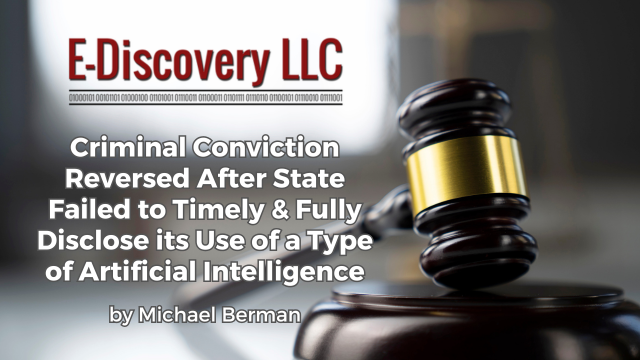
[EDRM Editor’s Note: The opinions and positions are those of Michael Berman.]
“After a one-day trial in the Circuit Court for Montgomery County, a jury found Craig Donnell Johnson guilty of robbery. Before trial, Mr. Johnson had filed a motion to dismiss the case, arguing that the State had withheld the fact that it had used facial recognition technology (‘FRT’) to identify him as the alleged perpetrator and had failed to disclose details about the technology and its outputs.” Johnson v. State, 2025 WL 2237582, at *1 (Appl. Ct. Md. Aug. 6, 2025)(unreported). The appellate court reversed the conviction.
The Court set a standard of timely disclosure of the use of A.I., or at least FRT, so it can be tested appropriately, at least in criminal cases. The State’s insistence “that it didn’t (and still doesn’t) know what FRT program the police used” was fatal. The late disclosure and lack of information “left Mr. Johnson unable to attack the reliability of the FRT….”
FRT IS A FORM OF ARTIFICIAL INTELLIGENCE
“Face recognition is a form of artificial intelligence (AI) that mimics a human capability to recognize human faces.” What Is Face Recognition? | Microsoft Azure
“At the heart of facial recognition technology lies artificial intelligence—more specifically, machine learning and deep learning algorithms. These algorithms are trained on vast datasets of faces, learning to recognize subtle patterns that distinguish one face from another.” M. Tuhin, What is Facial Recognition Technology? How It Works and Why It Matters in 2025 (Apr. 9, 2025).
“FRT is a type of AI that incorporates machine learning algorithms which identify patterns of facial features and matches a face to pictures of other faces from a large data base.” M. Gentzel, Biased Face Recognition Technology Used by Government: A Problem for Liberal Democracy – PMC (Sep. 25, 2021)(National Library of Medicine).
“Facial recognition technology (FRT) is a type of biometric recognition technology that uses artificial intelligence (AI) to identify individuals through their facial features.” B McPhail, Facial recognition explained: How is FRT used in Canada? – CCLA (Dec. 6, 2022).
FACTS OF JOHNSON
During a robbery in a store, an individual attacked a store employee. The assailant took some money and fled. A police detective retrieved footage from the store’s surveillance cameras. The detective “submitted a still photo from the footage to a department-wide informational board and later developed Mr. Johnson as a suspect.”
Surveillance followed. During surveillance on February 21, 2023, police “saw a man who resembled the assailant in the still photo entering and exiting the house.” A search warrant was executed and, among other things, clothing matching the video was obtained. Mr. Johnson was arrested and remained in pre-trial detention until his trial on February 20, 2024.
AFTER UNTIMELY DISCLOSURE DISCOVERY AND BRADY VIOLATIONS ALLEGED
The Appellate Court wrote: “Not until about a week before trial did the State disclose to defense counsel that the police had entered the still surveillance photo into an FRT, which, the State claimed, generated only one result: Mr. Johnson.”
The FRT generated Mr. Johnson’s identity from the primary source store video and became the source—the fruit-bearing tree, as it were—of everything that flowed from it.
Johnson v. State, 2025 WL 2237582 (Appl. Ct. Md. Aug. 6, 2025)(unreported).
Mr. Johnson acted promptly: “The day before trial, Mr. Johnson filed a motion to dismiss the case in which he claimed that the State committed a Brady1 violation by failing to disclose until February 12, 2024—nearly a year after defense counsel submitted his discovery demands—the fact that the police used FRT to develop Mr. Johnson as a suspect.”
A few days later, on February 16, 2024, Mr. Johnson asked for information about the FRT search. The Court wrote: “[T]he State provided a three-page email that was sent to Detective Dyer on February 21, 2023 that contained the surveillance photo, Mr. Johnson’s MVA photo and mugshot, and some information about him.”
In response to that “disclosure”: “Mr. Johnson argued that FRT searches are designed to produce more than one result, but this email contained no information on any other suspects generated (if any), nor did it identify the software used to conduct the search.”
Mr. Johnson also argued that “this last-minute, bare bones disclosure left him with inadequate time and information to prepare to attack the reliability of the FRT search at trial and that the court should dismiss the case without prejudice.”
Both the State and the court viewed this as a discovery issue, not a Brady2 issue. The Court wrote:
“[T]he State admitted that it had learned of the police department’s use of FRT in this case back in February 2023 but said that it didn’t know about the email until it conferred with Detective Dyer a week before trial. The State claimed that the email was the only document associated with the FRT search and that it had no other information. The State argued as well that Mr. Johnson wasn’t prejudiced by the police department’s use of FRT because the State didn’t intend to offer the email as evidence or to elicit testimony on how the police developed Mr. Johnson as a suspect. The State seemed to indicate that it hadn’t disclosed any information on the FRT search sooner because it didn’t intend to use it at trial and so didn’t believe it was necessary to disclose it.” [Emphasis added].
Johnson v. State, 2025 WL 2237582 (Appl. Ct. Md. Aug. 6, 2025)(unreported).
Mr. Johnson was convicted before a jury and sentenced to 15 years of incarceration.
THE APPELLATE ANALYSIS
The Appellate Court wrote: “We hold that the circuit court abused its discretion when it denied Mr. Johnson’s motion to dismiss the case and we reverse that ruling.”
Maryland Rule 4-263(d)(7)(B) requires the State to disclose “[a]ll relevant material or information regarding … pretrial identification of the defendant by a State’s witness ….”
And having no access, even to this day, to information regarding the software used, the suspects generated by the search, or any other information on the FRT search and procedure (besides the one email) left Mr. Johnson unable to attack the reliability of the FRT search and, in turn, the credibility of the investigation that identified him.
Johnson v. State, 2025 WL 2237582 (Appl. Ct. Md. Aug. 6, 2025)(unreported).
The State did not dispute that it had committed a discovery violation. Much of the decision turns on why a postponement would not be an effective remedy for the incarcerated defendant.
The Appellate Court found that the prejudicial impact on Mr. Johnson was “significant.” It wrote:
The victim in this case didn’t identify Mr. Johnson before trial and there was no physical evidence connecting him to the robbery directly. Although Detective Dyer said he could make out a face from the video, the FRT was the only way that police connected Mr. Johnson to the case. Everything else, the court noted correctly, “stemmed from … the officer utilizing this extra software” (i.e., the FRT). The FRT search prompted Detective Dyer to look at Mr. Johnson as a suspect, which prompted the surveillance at Mr. Johnson’s house, the search of his house, and ultimately, his arrest. And yet there was no way for the defense to investigate or challenge the identification. [Emphasis added].
Id.
The State’s argument was insufficient:
The State insisted that it didn’t (and still doesn’t) know what FRT program the police used and that it didn’t have any additional information to produce. And it doesn’t matter that the State never intended to introduce evidence of the FRT search at trial. The FRT generated Mr. Johnson’s identity from the primary source store video and became the source—the fruit-bearing tree, as it were—of everything that flowed from it.
Id.
In short, according to the Court:
The late disclosure of the use of the FRT put Mr. Johnson at a significant disadvantage in preparing his defense. And having no access, even to this day, to information regarding the software used, the suspects generated by the search, or any other information on the FRT search and procedure (besides the one email) left Mr. Johnson unable to attack the reliability of the FRT search and, in turn, the credibility of the investigation that identified him. The FRT search came as a surprise to Mr. Johnson just a week before trial and left him with no meaningful opportunity to prepare a defense to it, so Mr. Johnson was prejudiced by the State’s discovery violation. [Emphasis added].
Id.
THE APPELLATE COURT’S DISCUSSION OF ARTIFICIAL INTELLIGENCE
In this unreported decision, the intermediate appellate court discussed A.I.:
The State’s discovery violation carries greater significance, and inflicted greater prejudice on Mr. Johnson, in the context of the FRT technology that the State admits to using here. There is ample reason to question the reliability of evidence generated by FRT and artificial intelligence (“AI”) more broadly, and we would send exactly the wrong message if we allowed the State to rely on an FRT-generated identification without accountability. FRT has produced unreliable results in multiple instances across the country, including here in Maryland. [Emphasis added].
Id.
After giving examples of erroneous FRT cases, the Court wrote:
Our courts must, and will, recognize the power and opportunity AI tools can offer. But the very real prospect that AI could hallucinate evidence, as it does text and citations when it can’t find an answer, … places all the greater imperative on allowing FRT- and AI-generated evidence to be tested appropriately, and we cannot give the State a pass here where it failed even to identify the technology it used to identify the suspect it pursued and prosecuted. [Emphasis added].
Id.
Because a postponement would not mitigate the prejudice, the Court reversed.
JOHNSON IS UNREPORTED
The Court wrote: “This is an unreported opinion. This opinion may not be cited as precedent within the rule of stare decisis. It may be cited for persuasive value only if the citation conforms to Maryland Rule 1-104(a)(2)(B).”
Rule 1-104 was amended to add exceptions that may permit citation of Johnson. Elimination of Judicial Disappearing Ink in Maryland (May 6, 2023).
Some unreported decisions, like Johnson, have decided novel issues. For a recent e-discovery example, see Maryland Appellate Decision Permitting Limited Forensic Search of Non-Parties’ Cell Phones. In that case, St. Frances Acad. v. Gilman Sch., Inc., 2022 WL 833371, at *1 (App. Ct. Md. Mar. 21, 2022), the Court described a cell phone discovery issue as “a case of first impression….” For another example, Admissibility of Internet Searches About Terminating Pregnancy (Jun. 5, 2024), later decision by Supreme Court of Maryland, Evidence of Internet Searches About Lawful Abortion Held Inadmissible to Prove Intent to Later Kill or Harm Newborn Baby (Feb. 20, 2025).
Notes
- Brady v. Maryland, 373 U.S. 83 (1963). ↩︎
- Id. The Appellate Court wrote: “Here, the State provided so little evidence on the FRT search that we are unable to determine whether that information is exculpatory. We focus instead on his discovery claim.” ↩︎
Assisted by GAI and LLM Technologies per EDRM GAI and LLM Policy.


